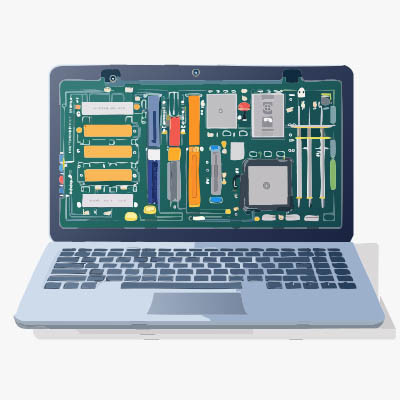Washington Works Blog
In managing business technology, we are always talking about downtime--how expensive downtime is, how downtime hurts productivity, how there are a multitude of separate situations that can cause downtime. That kind of doom and gloom may not get you to act, but it may just put you off. Today, instead of downtime, we thought we would talk about uptime.
When you’re talking about something to do with a computer, you’re going to start hearing about some word that ends with “-ware.” You could probably list off a few yourself, but have you ever stopped to think about why they’re all described as “something-ware?” For this week’s Tech Term, we’ll take a peek at why we refer to things that way.
The term “hacker” is possibly one of the best-known technology-related terms there is, thanks to popular culture. Properties like The Girl with the Dragon Tattoo and the Die Hard franchise have given the layman a distinct impression of what a hacker is. Unfortunately, this impression isn’t always accurate. Here, we’ll discuss what real-life hackers are like, and the different varieties there are.
It is no secret that security is an absolutely crucial part of computing in the modern era. Data can very fairly be called the most valuable currency today, which means it needs to be protected. One way to do this is through the use of encryption keys. In this Tech Term, we’ll go over how these keys can protect your data, and how they do so.
Computers use quite a lot of different types of protocol to function. In particular, the Internet takes advantage of protocol to a great degree. You might recognize terms like Hypertext Transfer Protocol Secure, Transmission Control Protocol/Internet Protocol, File Transfer Protocol, Internet Message Protocol, and Post Office Protocol. But what exactly is protocol, and why is it important?
Sometimes it can be hard to diagnose a problem with your PC. While it might not be something system-breaking, it’s still important to find the root of an issue before it becomes a major problem. One of the best ways to diagnose an issue with your computer is by logging in using Safe Mode. We’ll talk about when and how you can use Safe Mode to your computer’s benefit.
In some situations, competition is good for a business; and, for others, it can be terrible. As marketing, and specifically online marketing becomes more imperative for the success of every organization, all the content that is created for this purpose has to be managed. For this week’s technology term, we take a look at the different kinds of content management services (CMS) and what they do to make managing your organization’s content simpler.
Running a business sometimes requires attention to very minute details, and some things must be measured in order to achieve optimal efficiency. You’ve likely heard the terms bits and bytes used regarding data storage or transfer, but do you know what the difference is between them? Today’s tech term is dedicated to this explanation.
We often take for granted that people know what we are talking about when we talk about popular connectors, but really how do these systems work? For this week’s tech term, we are going to take a look at something we all have used and probably are actively using: the Universal Serial Bus (USB). We will take a look at the origins of this technology, the development of it, and how it is being used today.
Chromebooks are a pretty common device at this point, and this popularity only makes sense. For many, the Chromebook offers basic features that serve their purposes well, but there are those who wouldn’t be satisfied with their capabilities. This week, our Tech Term is Chromebook, so let’s take a closer look to gain a deeper understanding of them.
The Internet has become an irreplaceable part of many business’ operations, which brings the thought into question of how much you rely on it for your daily duties. Technology has changed the way that the Internet works for the better, but there is one part of its operations that still lies at the heart of it: bandwidth.
The Internet is a valuable tool that can be accessed through a wired connection and wirelessly via Wi-Fi, but the devices that offer these connections can be somewhat complicated and difficult to understand. If you don’t know which device does what, you’re in for a treat--today’s tech term will examine the differences between the modem and the router.
There are plenty of technical terms and solutions that, while heard of frequently enough, it may not be completely clear what they mean or refer to. A proxy server is an excellent example of such a solution. This week, we’ll examine this tech term and review how utilizing proxy servers can help your business.



















